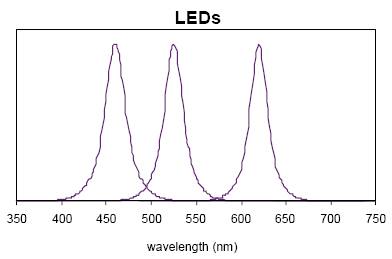Optipedia • SPIE Press books opened for your reference.
Light Emitting Diodes (LEDs)
Excerpt from Field Guide to Illumination
LEDs are moderately narrowband emitters with an approximately Gaussian spectral shape. The spectrum of an LED is often expressed by a single wavelength, with four different single-wavelength descriptions in general use. The most common spectrum-based description is the peak wavelength, λp, which is the wavelength of the peak of the spectral density curve. Less common is the center wavelength, λ0.5m, which is the wavelength halfway between the two points with a spectral density of 50% of the peak. For a symmetrical spectrum, the peak and center wavelengths are identical. However, many LEDs have slightly asymmetrical spectra. Least common is the centroid wavelength, λc, which is the mean wavelength. The peak, center, and centroid wavelengths are all derived from a plot of Sλ(λ) versus λ. The fourth description, the dominant wavelength, λd, is a colorimetric quantity that is described in the section on color. It is the most important description in visual illumination systems because it describes the perceived color of the LED.
Spatially, LEDs, especially those in lens-end packages, are often described by their viewing angle, which is the full angle between points at 50% of the peak intensity.

A. V. Arecchi, T. Messadi, and R. J. Koshel, Field Guide to Illumination, SPIE Press, Bellingham, WA (2007).
View SPIE terms of use.

